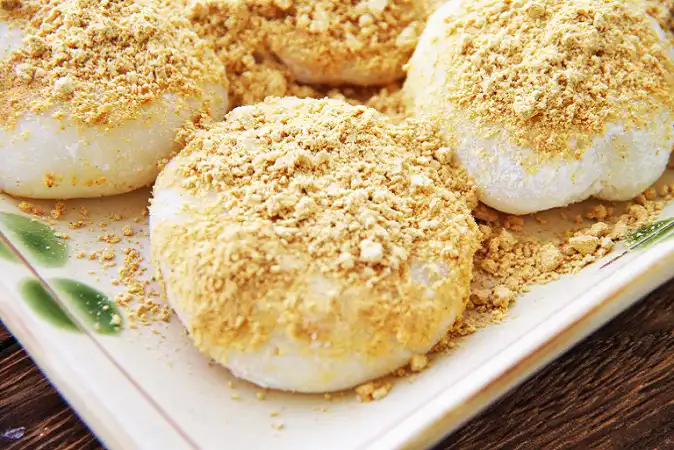Metric:
Mochi
30gr Kinako
( Soy Bean Flour )
30gr Sugar

TRADITIONAL JAPANESE RECIPE: Here's another recipe for Mochi! This is traditionally eaten at New Year's for good luck, but it is so delicious and easy to make you will find that people eat it all the time as a treat with tea.
Another traditional use for kinako is another wagashi, called Warabi Mochi (蕨餅). It's made from braken fern starch, which makes it more jelly-like than mochi made with rice, and it is served rolled in kinako.
Kinako (黄粉 or きなこ), also known as roasted soybean flour, is a product commonly used in Japanese cuisine. In English, it is usually called "roasted soy flour". More precisely it is "roasted whole soy flour". Usage of the word kinako appeared in cookbooks from the late Muromachi period (1336–1573). Kinako means "yellow flour" in Japanese.
Production:
Kinako is produced by finely grinding roasted soybeans into powder. The skin of the soybean is typically removed before pulverizing the beans, but some varieties of kinako retain the roasted skin. Yellow soybeans produce a yellow kinako, and green soybeans produce a light-green product. Kinako, being composed of soybeans, is a healthy topping and flavouring which contains B vitamins and protein. Compared to boiled soybeans, however, the protein in kinako is not easily digested.
Usage:
Kinako is widely used in Japanese cooking, but is strongly associated with dango and wagashi. Dango, dumplings made from mochiko (rice flour), are commonly coated with kinako. Examples include ohagi and Abekawa-mochi. Kinako, when combined with milk or soy milk, can also be made into a drink. One example of its use in popular foods is warabimochi, which is a famous kinako-covered sweet.
WARNING:
The buns are chewy and sticky. Given they are far bigger than bite-sized, they need to be laboriously chewed before swallowing.
Anyone who can't chew properly - like children, or the elderly - will be likely to find them hard to eat.
Chew, chew, chew. If that's not possible, the rice cakes need to be cut into smaller pieces.
Each year, authorities issue public warnings in the run-up to the new year festivities advising that people - especially the very young and elderly - should only eat mochi cut down to smaller little chunks.
Yet despite the warnings, each year there continue to be deaths linked to the dish.
At the turn of 2014 to 2015, the number of casualties peaked at nine. In 2016 it was one, while last year two people died.
Each year, many more end up in critical condition in hospitals across the country.
| Skill Level: |
Time: 15 Minutes |
| Price: |
Serves: 4 People |
Ingredients:
| Conversions |
Directions:
01 - Boil water in a pot.
02 - Cook Mochi in boiling water for 3-4 minutes.
03 - In a bowl or plate, mix Kinako and Sugar.
04 - Remove Mochi from hot water, and coat with Kinako mixture. Serve warm or cold.
| Written by: Uncut Recipes | Disclaimer |

| YOU MIGHT ALSO LIKE: |
| LATEST RECIPES: |
Ima
September 14, 2019 Love this recipe thank you. I doubled the amounts and ended up with extra mochi. |
Tania
August 31, 2019 I've swapped the kinako with the korean kong garu (roasted soybean powder) and it was still great. |
Beth
August 1, 2019 There's a indian breakfast dish that’s very similar to this. Rice flour is steamed and served with coconut flakes. I'll try this recipe because it's very very interesting. I tried Mochi in Japan and I miss them so much. I'll also try to top them with some cocnut. |

October 08, 2019
I've tried a multiple combinations: honey, sugar, chocolate, misutgaru (roasted mix grain powder) and maple. All of them great. I could eat mochi 24/7. thank you for sharingthis recipe.